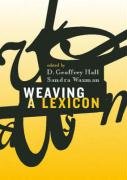Bradford Books
Weaving a Lexicon
Couldn't load pickup availability
Author: D Geoffrey Hall
ISBN: 9780262582490
Publisher: Bradford Books
Published: 2004
Binding: Paperback
Language: English
Condition: Used: Very Good
Clean, unmarked copy with some edge wear. Good binding. Dust jacket included if issued with one. We ship in recyclable American-made mailers. 100% money-back guarantee on all orders.
Psychology 1563463
Publisher Description:
The studies in Weaving a Lexicon make a significant contribution to the growing field of lexical acquisition by considering the multidimensional way in which infants and children acquire the lexicon of their native language. They examine the many strands of knowledge and skill--including perceptual sensitivities, conceptual and semantic constraints, and communicative intent--that children must weave together in the process of word learning, and show the different mix of these factors used at different developmental points. In considering the many different factors at work, the contributors avoid both the either-or approach, which singles out one strand to explain word learning throughout childhood, and the all-inclusive approach, which considers the melange of factors together. Their goal is to discover precisely which strands of ability or understanding make which contributions to acquisition at which points in infancy and childhood.The nineteen chapters are arranged in two broadly thematic sections. The chapters in Initial Acquisitions, focus on issues involved in word learning during infancy, including how learners represent the sound patterns of words, infants' use of action knowledge to understand the meaning of words, and the links between early word learning and conceptual organization. In Later Acquisitions, the chapters treat topics concerning the stages of toddler and preschooler language acquisition, including part-of- speech information in word learning, the proper-count distinction, and a comparison of verb acquisition in English and Spanish. Because the contributors present their work in the broader context of the interconnection of different processes in lexical acquisition, the chapters in Weaving A Lexicon should suggest new directions for research in the field.

